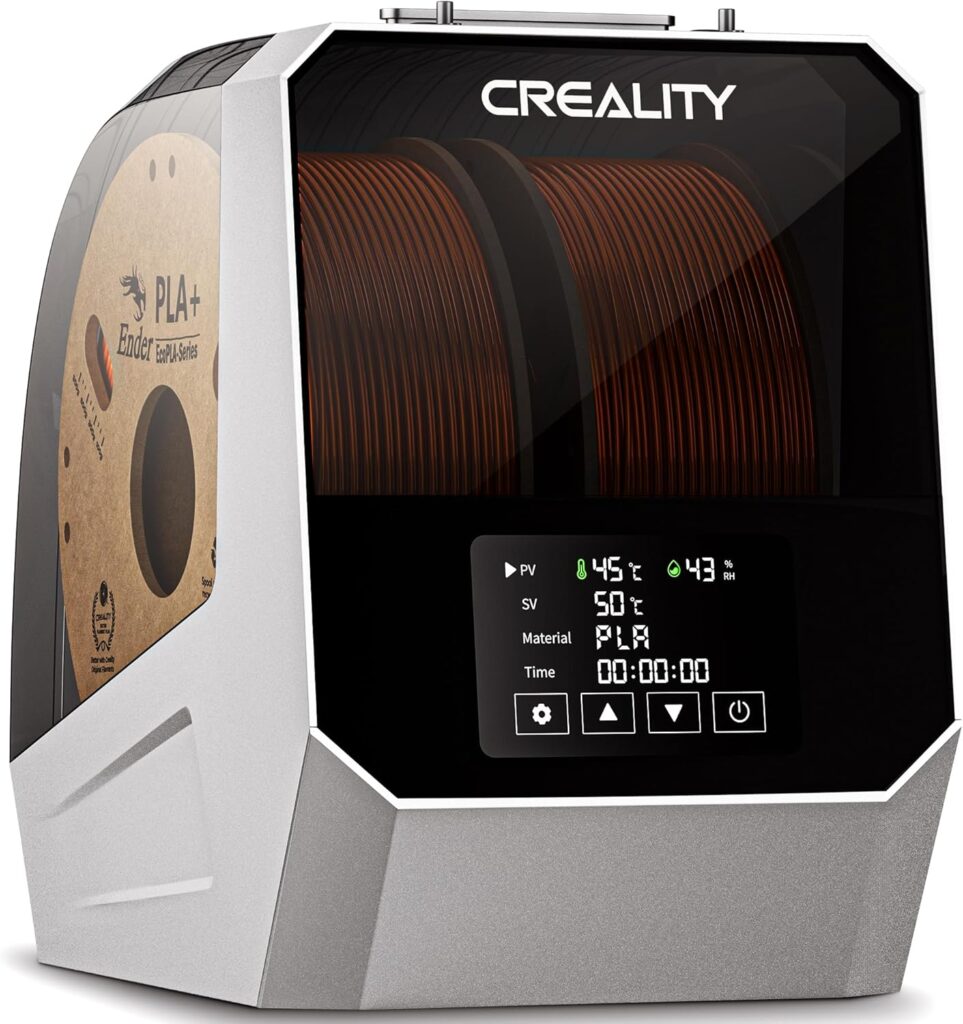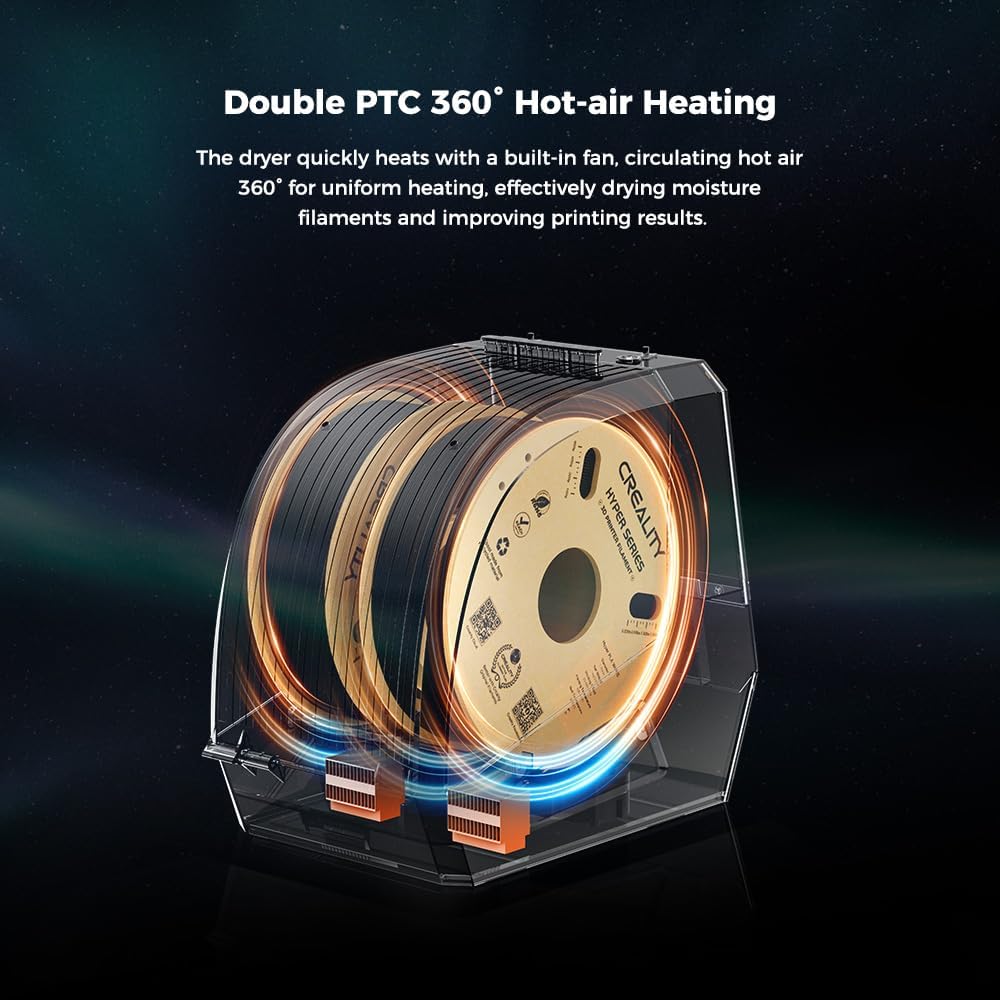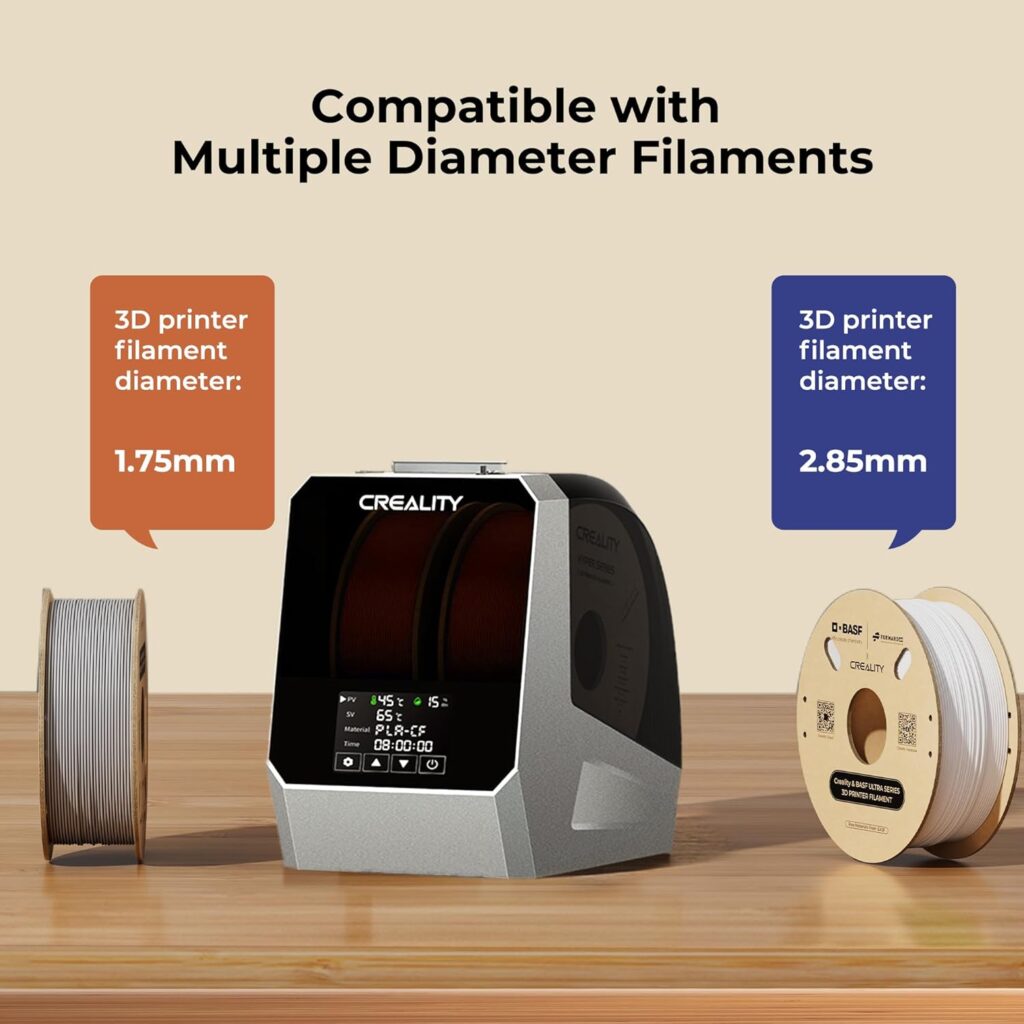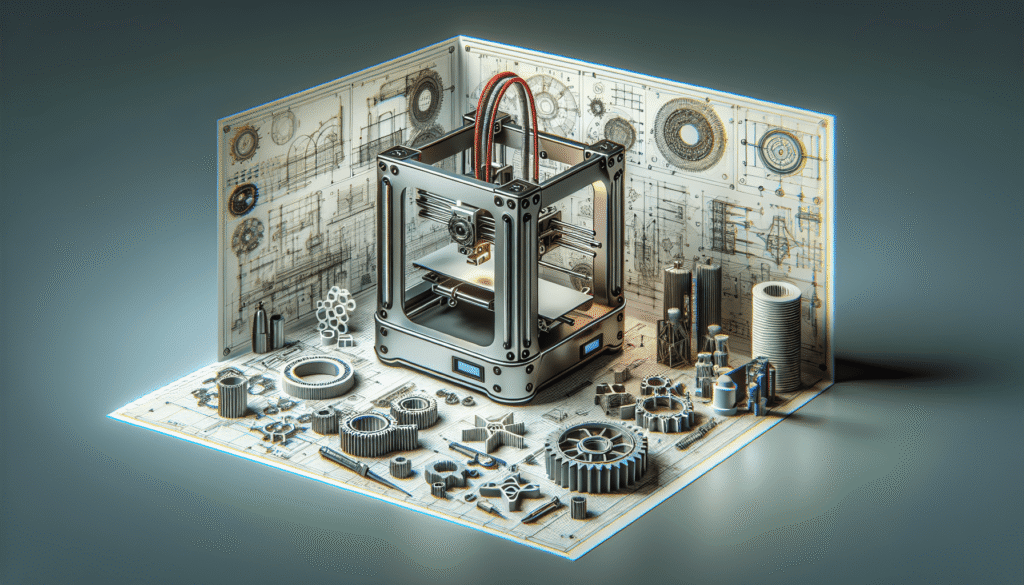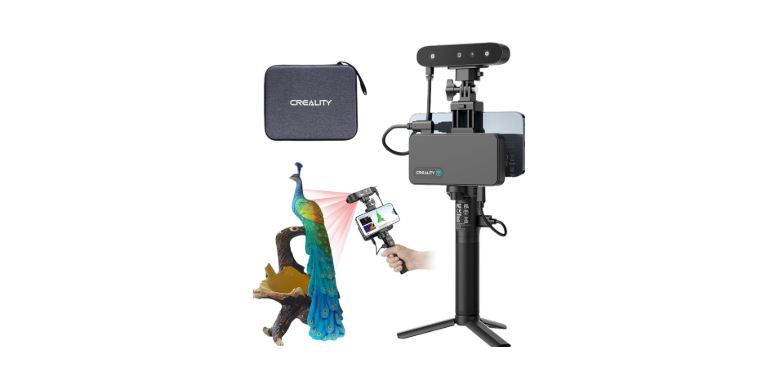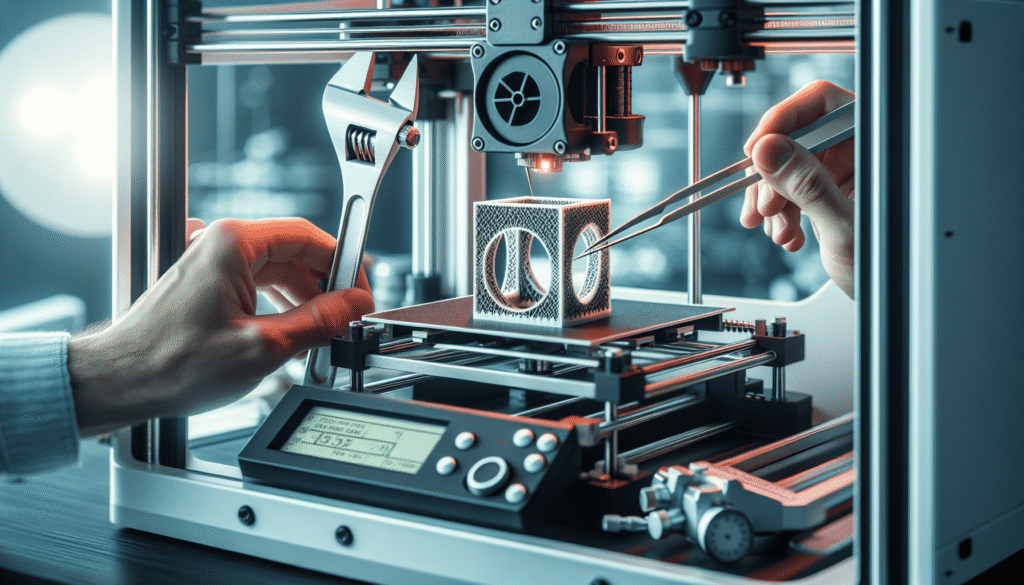Have you ever watched your printer cough up stringy noodles and thought, “It’s not me, it’s the humidity”?
Why I Finally Got Serious About Drying Filament
I used to treat filament like pantry spaghetti: toss it on a shelf, use it when I felt inspired, and assume it would behave. Then summer rolled in, the air turned into soup, and my prints started sounding like a cough. I’d hear pops and see bubbly edges, and I’d rationalize it as “quirkiness.” It wasn’t. It was moisture. That’s when I started using the Creality Filament Dryer Box—specifically, the Dual-Spool Creality Space Pi Filament Dryer Plus with a PTC heater and a 4-inch touchscreen—and the difference was the kind that makes you feel both grateful and slightly ashamed for waiting so long.
Creality Filament Dryer Box,Dual-Spool Creality Space Pi Filament Dryer Plus with 360° Fast Heating & PTC Heater,4
$79 In Stock
What Stood Out About the Space Pi Filament Dryer Plus
This unit dries two 1KG spools at once and has four PTFE-lined ports to feed filaments to one or two printers while it runs. The heater is PTC-based, which means it warms up quickly, holds temperature evenly, and doesn’t guzzle power like a competitive eater. The fan inside circulates heat 360 degrees, so the spools don’t get the hot-side/cold-side treatment. That alone kept me from repositioning spools like a rotisserie chef.
A Touchscreen That Doesn’t Make Me Squint
The 4-inch color touchscreen is bright and intuitive. I tap a preset for PLA, ABS, PETG, TPU, ASA, PC, PA (nylon), PET, or their carbon fiber versions, set a time, and it goes. If I want to tweak, I can: 45–70°C for up to 48 hours. It remembers my last settings after a power outage, which is the kind of small courtesy I appreciate, especially after tripping the breaker with a toaster and a space heater.
The Design: Compact, Efficient, and Not Ugly
If you’ve ever had a single-spool dryer hog your desk like a sullen teenager on a sofa, the dual capacity of this one feels liberating. It’s compact for what it does, and because it can feed two printers directly, I don’t have to clutter my workspace with more boxes. The PTFE-lined ports feel deliberate and smooth—nothing catches, nothing grinds, and my Bowden setups remain drama-free.
Build Quality and Materials
Everything feels sturdy without being heavy. The lid seals with reassuring intent, the inner spindles hold both standard 1KG spools and some of the slightly wider “personality spools” I keep buying because I like their fonts. The fan is placed so airflow curls around both spools evenly, which shows in how consistent my results have been.
Setup: From Box to Drying in Five Minutes
Setting it up took four minutes if I include the time I spent peeling protective film with the focus of a surgeon. I plugged it in, placed two spools, threaded filament through the PTFE ports, and selected a preset. The first thing I noticed was how quickly it reached temperature—PTC heaters don’t mess around—and the steady hum felt like a small, polite vacuum cleaner. Not silent, but not intrusively loud.
The Presets: One-Touch Sensibility
Presets exist for 12 common materials and their carbon fiber blends: PLA, Silk PLA, ABS, PETG, TPU, ASA, PC, PA (nylon), PET, and the CF versions of some of those. I use the factory values as a baseline, then fine-tune temperature and time depending on how humid my workshop has been (which, lately, is very).
Manual Mode for Control Freaks
When I want to take control, I set my own time (anywhere up to 48 hours) and temperature (between 45 and 70°C). I’ve found that 70°C is great for nylon and PC, while PLA lives comfortably around 50–55°C. TPU can be finicky, so I keep it closer to 45–50°C. The interface lets me nudge values without feeling like I’m programming an airliner.
Why the PTC Heater Matters
PTC heaters are inherently self-regulating, ramping up quickly and maintaining a steady output without overshooting. I’ve used dryers with PI elements that felt like enthusiastic campers: they get hot, but distribution isn’t always uniform. With PTC and a 360-degree airflow pattern, I don’t babysit. I set it, let it run, and the filament behaves afterward.
Even Heating Reduces Problems I Thought Were “Normal”
Moisture, it turns out, was behind more of my problems than I wanted to admit. PLA stringing, PETG zits, ABS layer adhesion worries, TPU blobs that make my printer look like it has the shakes—all of that improved with proper drying. It’s not magic. It’s just physics properly applied. I still mess up temperatures and speeds on my printer sometimes, but at least the filament shows up ready.
The Results: Material by Material
I tested a bunch of materials that had started to misbehave. I weighed spools before and after, paid attention to extrusion sound, watched surfaces, and tried not to cry when older spools came back to life like they’d just had a nap.
PLA and Silk PLA
PLA isn’t the thirstiest plastic, but it picks up just enough moisture to cause tiny pops and stringing. After 6 hours at 50–55°C, the silk finishes regained their sheen without the weird splotchy matte sections. The normal PLA prints got cleaner corners and less wispy hair. I also noticed that the first layers were more even, especially on prints with broad bases.
PETG
PETG is sensitive; it’s the guy at the party who politely declines anything with cilantro. Six hours at 55–60°C made a very noticeable difference in surface smoothness and reduced those little snotty pearls at retractions. I still have to tune speeds, but dried PETG is far better behaved. Overall success rate improved from “gritting my teeth” to “calm adult.”
ABS and ASA
I used to think ABS was angry with me personally. After 8–10 hours at 65–70°C, ABS prints had fewer layer splits, and ASA produced crisper corners. Drying doesn’t eliminate the need for an enclosure or good ventilation, but it definitely reduces frustration. The matte finish on ASA in particular looked more consistent after drying.
TPU
TPU is fun until it isn’t. Moisture turns it into a squeaky mess. Four to six hours at 45–50°C made a substantial difference in stringing and weird texture. Once dry, TPU extrudes like butter and behaves on retractions like it’s been to therapy.
Nylon (PA) and Nylon Blends
Nylon is always thirsty. It will drink ambient humidity like a marathoner at a water station. I dry nylon for 12–24 hours at 70°C, depending on just how swampy my shop has been. After a day inside the Space Pi, nylon prints fused layers like epoxy and the parts felt stronger. Stringing dropped dramatically, and holes and tolerances became predictable again.
PC and PET (Non-G)
Polycarbonate responds well to 70°C for 6–8 hours. The prints show fewer bubbles, more clarity where applicable, and better inter-layer strength. PET (not PETG) benefits from careful drying at 55–60°C and then behaves like a more civilized cousin.
Carbon Fiber Variants
CF-reinforced filaments shrink less and warp less, but they’re still sensitive to moisture. I’ve had great results by using the same base-material temperatures but giving CF blends an extra couple of hours. The Space Pi’s presets for CF make it easier, and I haven’t felt the need to second-guess them.
Dual-Spool Drying: Twice the Utility
The Space Pi dries two 1KG spools at the same time. That has saved me a lot of time when I’m prepping for a weekend of printing or when a friend shows up holding a soggy spool and a look of regret. And with four PTFE-lined ports, I can feed two printers or route filament forward or back as needed.
The Ports Are Smooth and Practical
PTFE-lined ports reduce friction as filament feeds out. My Bowden setups thank me, and my direct drive printers stay drama-free. Also, I don’t hear any scratching or dragging, which used to be a silent killer of my extruder performance.
The Data: Before-and-After Results
I’m not a lab, but I did record some numbers. I weighed spools and took humidity readings in the dryer chamber. This shows what I saw in normal, humid conditions.
| Material | Starting Condition | Drying Settings | Weight Change | Print Difference |
|---|---|---|---|---|
| PLA | Mild stringing, tiny pops | 55°C, 6h | -3–6 g | Sharper corners, less stringing |
| Silk PLA | Dull patches, micro-bubbles | 50°C, 6h | -4–7 g | Smoother sheen, uniform finish |
| PETG | Zits, stringing | 60°C, 6h | -6–10 g | Smoother walls, cleaner retractions |
| ABS | Layer splits in tall parts | 70°C, 8h | -5–9 g | Fewer splits, better layer bond |
| ASA | Warping edges | 70°C, 8h | -5–8 g | Improved corner fidelity |
| TPU | Unreliable extrusion | 50°C, 6h | -2–4 g | Reduced stringing, consistent flow |
| Nylon (PA) | Severe stringing, brittle | 70°C, 24h | -15–25 g | Strong layers, crisp holes |
| PC | Bubbles, poor adhesion | 70°C, 8h | -8–12 g | Clearer print, stronger layers |
I don’t pretend weights are perfectly accurate—spool adhesives vary, and some filaments soak up moisture like emotional support sponges—but the trends are unmistakable.
Suggested Settings I Actually Use
Presets cover most of this, but here’s how I tend to run things based on my shop conditions.
| Material | Temp (°C) | Time | Notes |
|---|---|---|---|
| PLA | 50–55 | 4–8 hrs | Watch silk finishes; 55°C sweet spot |
| Silk PLA | 50–55 | 6–8 hrs | Protect shine by avoiding over-temp |
| PETG | 55–60 | 4–8 hrs | Longer if visibly popping |
| ABS | 65–70 | 6–10 hrs | Keep enclosure around printer for best results |
| ASA | 65–70 | 6–10 hrs | Benefits from a little extra time |
| TPU | 45–50 | 4–6 hrs | Gentle drying reduces stringing |
| Nylon (PA) | 70 | 12–24 hrs | Longer in high humidity |
| PC | 70 | 6–10 hrs | Improves clarity and bonding |
| PET | 55–60 | 4–8 hrs | Don’t confuse with PETG |
| CF blends | Base + 0–5°C | +2 hrs | Slightly longer than base material |
These values sit comfortably in the Space Pi’s 45–70°C temperature range and stay within 48-hour time limits. I rarely need more than a day, except for aggressive nylon recovery.
Power Outages and Memory Retention
One of my less charming hobbies is running too many appliances at once. When the power goes out, the Space Pi remembers its last settings. That means I can reset the breaker, return to my project, and the dryer resumes memory like a reliable friend who remembers where I left off in a conversation. It’s small, but it reduces a real kind of nuisance.
Noise, Smell, and Safety
The fan hums. It’s not silent, but it lives in the background like an air purifier or a calm refrigerator. I haven’t noticed any odd odors during use. The housing never feels dangerously hot; even at 70°C inside, the exterior remains approachable. The PTC heater’s self-regulating nature inspires more confidence than a simple resistive setup. I still keep it on a solid, flat surface with adequate space, because I don’t tempt fate, especially with warm plastic.
Energy Consumption and Cost to Run
I measured approximate draw with a smart plug. At 55–60°C, it tends to hover between 30 and 60 watts once up to temperature (spiking a bit during warm-up). Running for eight hours is generally under half a kilowatt-hour, which, in my area, is cheaper than the coffee I drink while watching it. Nylon marathons at 70°C use more, of course—but the reward in print quality and part strength justifies it for me.
Space and Aesthetics
It’s compact for a dual-spool unit and looks tidy on my bench. The lid opens smoothly, which matters more than I expected when I’m swapping spools in a hurry. The minimal, clean design means I don’t mind seeing it in the background of my workspace photos—granted, those photos also feature dust and a very opinionated caliper.
The Touchscreen: Bright and Legible
I prefer buttons to cryptic LCDs, but here the 4-inch touchscreen makes sense. The icons are clear, the font is readable, and my fingers don’t miss the hit targets. I can adjust in seconds without hunting through submenus, and that encourages me to dry more often, which is the whole point.
Feeding Printers Directly: Less Clutter, More Printing
Feeding filament straight from the dryer sounds like a luxury until you do it a few times and realize it’s also a cleanliness boost. Dust and moisture stay out, and you avoid that moment when exposed filament scrapes across your desk collecting who-knows-what. The PTFE liners keep friction low, so my extruders don’t work any harder than usual.
Avoiding Tangles and Other Nightmares
I used to blame tangles on filament manufacturers. Then I realized I am sometimes the problem. With the Space Pi, the spools sit securely, and the ports align to keep the filament path sane. If you thread carefully and keep a moderate bend radius, tangles become rare. I also place a small clip on each filament tip when the dryer is off to keep coils tight.
Everyday Quality-of-Life Wins
Little things combine to make the Space Pi a pleasure:
- The interior warms evenly, so both spools dry predictably.
- The 48-hour cap accommodates the worst humidity cases I’ve had.
- Four ports give me routing options without contortions.
- The lid seals well, reducing the post-dry reabsorption risk.
- The presets remove guesswork but leave room for control.
It’s the kind of product that restores confidence to your workflow. I’d been doing “make-do” for a while; this made me feel competent again.
Reliability, Warranty, and Support
I’m not shy about warranty terms because I’ve been burned before. This unit comes with a 1-year replacement guarantee, and Creality’s tech support runs 24/7. I’ve only needed basic guidance once (I had a question about running longer sessions for nylon), and the response was prompt. It’s not just about fixing problems; it’s about not feeling stranded.
Using It as a Storage Box Between Prints
I wouldn’t call it a long-term storage vault, but leaving spools inside after drying—especially in humid months—does help. If I’m taking a weekend off, I keep the lid closed with spools inside so they don’t backslide. For multi-day prints, feeding directly out of the dryer is ideal. It’s like a dehumidifying guard dog, but without the barking.
Comparing It to Other Filament Drying Options I’ve Owned
I’ve tried single-spool dryers, modified food dehydrators, and the “put it in the oven and pray” method. Single-spool units are fine for hobbyists with one main filament—they just require more juggling. Food dehydrators can work, but airflow paths are not ideal for cylindrical spools, and I don’t love stacking rings around a spool like a totem in my kitchen. The oven is an absolute last resort; it dries inconsistently and risks deforming spools or turning PLA into an abstract sculpture.
This dual-spool Space Pi is the first one I’ve used that feels like a permanent part of my workflow instead of a hack. It handles multiple filament types gracefully and earns the space it takes up.
What Could Be Better
Nothing is perfect, even the things we like.
- I’d love optional humidity readouts inside the box. I use a separate hygrometer, but integrated data would be convenient.
- A gentler “quiet mode” for very late-night sessions would be nice, even if it means slightly longer drying times.
- The interior height is good for most spools, but a couple of my comically wide reels required me to rearrange how I fed them through the ports.
None of these are deal breakers. They’re more like polite suggestions I’d send if the Space Pi had a comment box.
Tips That Helped Me Get Better Results
I picked up a few habits that improve outcomes, and my future self thanks me.
- Preheat for 10 minutes before adding very wet spools. It stabilizes airflow faster.
- Snip a meter off the filament tip after drying if you’ve had serious popping; the last bit can hold stubborn moisture.
- Keep bends gentle when feeding to a printer—especially for TPU.
- For nylon, schedule a longer session than you think you need, then seal the spool in a bag with desiccant if you’re not printing immediately.
- If you’re using it as a feeder, check that spool flanges aren’t rubbing; the interior tolerances are good, but not all third-party spools are saints.
- Re-run a shorter maintenance dry if your spool sits unused for a week in humid weather.
When I Use Presets vs. Manual
I use presets for PLA, PETG, ABS/ASA, and TPU because they’re spot-on for my environment. Manual comes out for nylon and PC, where I prefer 70°C with custom durations, and for CF materials when I want extended drying. Being able to override without fuss makes me more willing to adjust on the fly.
Who This Dryer Is For
If you print regularly with hygroscopic materials (nylon, PC, TPU, PETG), this is a quality-of-life upgrade. If you run two printers, it’s an obvious choice, since it dries and feeds both at once. If you’re new to 3D printing and wondering whether drying matters: if your environment is humid or your prints show stringing, popping, or dull patches, it does. If you only print occasionally with PLA in a very dry room, it’s still useful but less essential.
Who Might Not Need It
If you keep all your filament in a climate-controlled cabinet, print once a month, and live in a desert, you might not need a dedicated dryer. I support your minimalist lifestyle. For the rest of us, moisture is relentless, and a dual-spool dryer keeps you from constantly putting out fires.
Preserving Filament Integrity
I used to think drying was suspicious, like reheating leftovers one too many times. In reality, proper drying at the correct temperature preserves filament performance and fully restores print quality. I’ve revived spools I thought were a lost cause, including a nylon that had turned into a spaghetti fountain and a PETG that looked like a lava field. After a run in the Space Pi, they printed like they remembered who they were.
Edge Cases and Caution Notes
- Don’t exceed 55°C for silk PLA or you risk modifying its finish.
- TPU can droop if run too hot for too long; keep it under 50°C unless the manufacturer specifies otherwise.
- Always check your filament’s recommended drying temperature. Most brands fall within 45–70°C, but exceptions exist.
- If a spool core is low-temperature plastic, avoid the higher end of the range.
None of this is difficult—it just calls for common sense. The presets take you most of the way there.
Real-World Improvements I Noticed
- Print surfaces look smoother across all materials when dried first.
- Extruders stop “popping” mid-print, and the random tiny holes in otherwise perfect walls vanish.
- Layer adhesion probably improves more than anything else, especially for ABS/ASA and nylon.
- Supports peel away more cleanly when the filament is dry, which surprised me but makes sense in retrospect.
Storage Strategy After Drying
After drying, I keep spools in resealable bags with desiccant if I’m not printing immediately. If I’m printing in the next day or two, I feed directly from the Space Pi. There’s no sense drying for hours only to let moisture creep back in like an uninvited guest. The dryer box doubles as a holding chamber between jobs, which has reduced my “re-dry” sessions by half.
Simple Workflow That Works for Me
- Night before a print: load spools, set temperature and time, let it run.
- Morning: feed directly from the Space Pi to the printers, no detours.
- If I pause a project: leave spools inside with the lid closed.
- If it rains for a week: give active spools a 2-hour top-up dry every few days.
It’s not glamorous, but it has made my results predictably good rather than unpredictably okay.
The Little Things I Appreciate
- The door mechanism feels confident, not flimsy.
- The display doesn’t wash out under my bright bench lights.
- The ports’ PTFE liners are replaceable; I like gear that values longevity.
- It doesn’t become a space heater for the room, despite running warm inside.
Pros and Cons as I See Them
Pros:
- Dries two 1KG spools simultaneously; feeds two printers with four PTFE-lined ports
- Fast, even heating with a PTC heater and 360° airflow
- Clear 4-inch touchscreen with intuitive presets for 12 materials (including carbon fiber variants)
- Adjustable 45–70°C temperature and up to 48-hour timer
- Remembers last settings after power loss
- Meaningful improvements in print quality across PLA, PETG, ABS/ASA, TPU, nylon, PC, and more
- Compact footprint for the utility it provides
- 1-year replacement guarantee and 24/7 tech support
Cons:
- No built-in humidity readout
- Fan is audible, though not loud
- Some unusual spool shapes need careful placement
- I wish for an optional quiet mode for overnight sessions
None of these cons outweigh the benefits for me. They’re notes, not deal-breakers.
Value: What I Got for the Money
I judge value by how often I use something and whether it solves a real problem. This dryer ticks both boxes. It made my results more consistent, reduced wasted time, and allowed me to run two printers without juggling spools and boxes. I’ve printed more and thrown away less, which is my preferred ratio.
Final Thoughts: The Part Where I Admit It Just Works
The Creality Filament Dryer Box—the Dual-Spool Creality Space Pi Filament Dryer Plus with the 4-inch touchscreen and PTC heater—doesn’t try to impress with gimmicks. It focuses on what matters: fast warm-up, even drying, sensible presets, and the capacity to handle two spools at once. The memory feature after a power blip is a small but appreciated grace note. And the 1-year replacement guarantee and always-on support make it feel like a safe buy.
I started this thinking I could get away without a serious dryer. I ended it wondering why I spent so long normalizing mediocre prints. If moisture is the gremlin in your workflow—and it probably is—this is the kind of tool that restores control. I load it, pick a preset, and go back to printing things that don’t look like they need an apology.
Disclosure: As an Amazon Associate, I earn from qualifying purchases.
